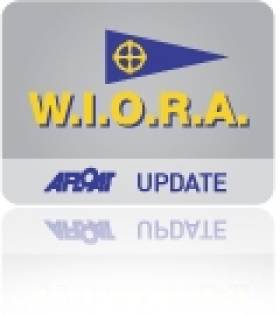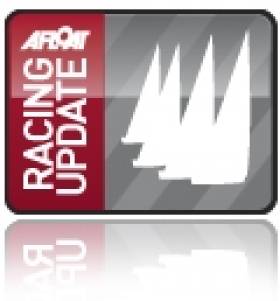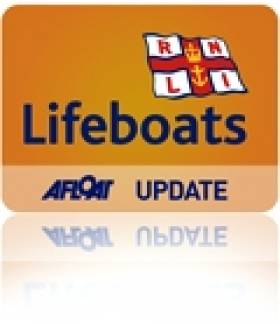Displaying items by tag: Clifden
Clifden Under Full Sail for WIORA Regatta Week
Clifden Boat Club's long awaited staging of the West Coast of Ireland's big regatta, WIORA week, kicked off today in perfect Atlantic conditions. It's the third time the event has been sailed at the boat club and the first since 2007. Below are today's first sailing photos from the 30-boat event by Gareth Craig.
Day one of the four day series went off with a bang with sunny skies and a light south-westerly breeze slowing building to a moderate breeze. Principal Race Officer Alan Crosbie and his team had their work cut out to get the two scheduled races in for the day with the tricky conditions.The fleet of just under thirty boats from Howth, Tralee, Clare, Limerick, Mayo, Sligo and Galway were all out on the water early for some pre-race preparation but also to bask in the sunshine.
Race One –
Class one saw early leader and last year's class winner Glen Cahill and his crew on the J109 Joie De Vie stamped his authority crossing the finishing line confidently after blasting away and leaving the rest of the fleet in his wake.
Class two saw David Griffin's Dehler 34 Egalite taking first from Brian Rafferty's Corby 2602 who travelled from Sligo Yacht Club to take part.
Class three it was local Jackie Ward on Hallmark showing the way from David Buckley's Sigma 33 from Tralee Bay Sailing Club.
Race Two –
During the afternoon the wind build to a constant 12 knots and champagne sailing conditions for the fleet.
In Class one it was the turn of the X332's to dominate the fleet with John Gordon's X-rated from Mayo Sailing Club taking line honours.
Class two Egalite just pipped Brian Rafferty's Corby gaining a second win for the day.
Class three it was the turn of David Buckley's Boojum to get one over on the local boat Hallmark finishing in the top slot
The forecast for day two is giving more of the same with blue skies with a westerly breeze.
WIORA Race Week Shaping up at Clifden Venue
With a week to go to the first gun of the West Coast Championships in Clifden Co. Galway, the 35th Anniversary event of the West of Ireland Offshore Racing Association (WIORA), is shaping up to be one to remember at Clifden Boat Club in County Galway.
At this year's West Coast Championships the race courses are being set by International Race Officer Alan Crosbie, taking full charge of the thirty boat plus fleet. There will be four days and seven races of various courses including a coastal race to decide the class winners and overall West Coast Champion.
Over the last thirty five years the association has gone from strength to strength which provides and promotes a programme of Inshore, Offshore and Coastal racing for cruisers, the association works very closely with the various clubs along the western seaboard.
Slightly down in numbers from previous West Coast Championships, but certainly not lacking in the quality of sailors and boats taking part.
Last year's Class One winner Glen Cahill's J109 'Joie De Vie' from Galway Bay Sailing Club is travelling to defend his title from such boats as fellow club sailor Liam Burke's Harley C33 'AWOL', Rob Allen's Corby 36 'Mustang Sally' and Dan Counihan's Beneteau 36.7 'Galileo' from Tralee Bay Sailing Club.
In Class Two Ray McGibney's Dehler 34 Optima 101 'Disaray' from Foynes Yacht Club, last year's class winner, West Coast Champion 2010 and who finished second overall at this year's recent ICRA National Cruiser Championships in Royal Cork Yacht Club will be up against strong competition from previous winner Cormac Mc Donncha's Beneteau 31.7 'Quelle Surprise' travelling from Galway Bay Sailing Club, Stephen Mullaney's Beneteau 375 'Walter Mitty' travelling all the way from Howth Yacht Club and Brian Raftery's Corby 26 '2602' from Sligo Yacht Club.
Class Three promises top class competition with host club sailor Jackie Ward's Parker 27 'Hallmark' will be up against fellow club sailor Paul Ryan's Toledo 30 'Saber', John Paul Buckley's Golden Shamrock 'Battle' from Foynes Yacht Club, Stephen Fitzgerald's First 30E 'Orient' from Mayo Sailing Club and Gary Fort's J24 'Jaguar' from Tralee Bay Sailing Club.
Prizes will be presented to the winning teams over the four days of the event for individual classes each day in both handicap systems IRC & ECHO.
On the final day of racing, Saturday, there will be prizes for the overalls in each class in both Handicap systems IRC and ECHO. For the production boat's, there is an added incentive with X-Yachts, Sigma and Beneteau putting up cup's for the best performing boat's overall in these categories.
And last, but definitely not least, the overall winners of the event. There will be a third and second overall out of all of the classes and finally the 2011 'The West Coast Champion' will be crowned.
Dramatic Photos of Clifden Lifeboat Battling Surf
John organised the training in response to the increased popularity of the area with surfers. RNLI Divisional Assessor Trainer Helena Duggan travelled to the lifeboat station to put 18 volunteer lifeboat crew through their paces and train them in handling the lifeboat in surf and responding to potential callouts from leisure marine enthusiasts.
Training is a core part of volunteering with the RNLI and each crewmember in Clifden trains once a fortnight on the stations two inshore lifeboats.
Commenting on the exercise John said, "I took my camera down to photograph the exercise and was really pleased with the results. It is great to be able to show the public what our lifeboat volunteers go through to ensure they are fit and trained to go to sea. We had a fantastic turnout on the day and the lifeboat crew learned about boat handling in surf conditions. We are delighted so many people are visiting the area for leisure marine activities."
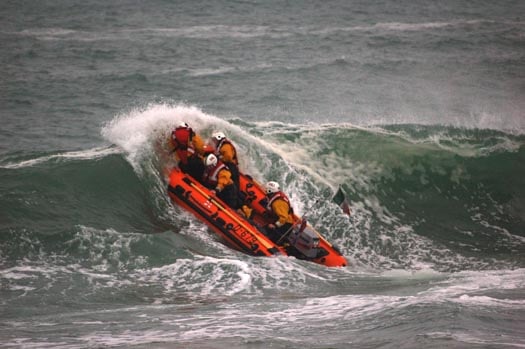
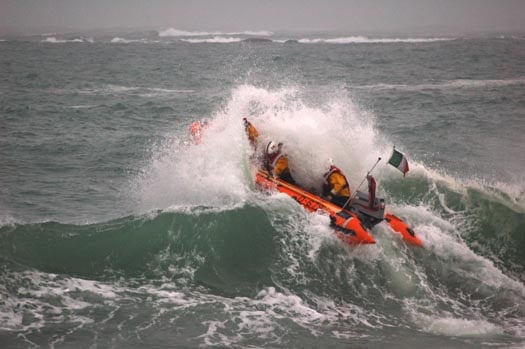
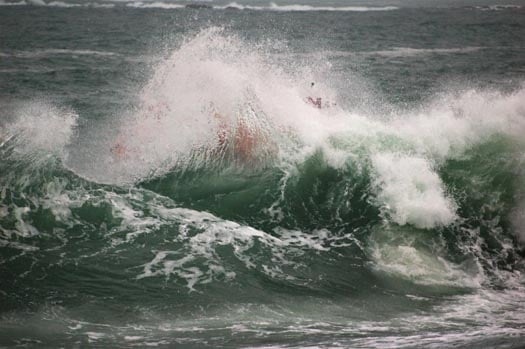
Photos by John Brittain/Clifden RNLI show Clifden volunteer lifeboat crew with RNLI Training assessor Helena Duggan during surf training on Dunloughan beach, Ballyconeely
Related Safety posts
RNLI Lifeboats in Ireland
Safety News
Rescue News from RNLI Lifeboats in Ireland
Coast Guard News from Ireland
Water Safety News from Ireland
Marine Casualty Investigation Board News
Marine Warnings
Two Investigations Underway into Weekend Boating Accident
Gardai launched a full investigation into the weekend boating tragedy where two men died in Inishboffin harbour.The men were identified locally as former Mayo footballer, Ger Feeney, and businessman, Donal McEllin, both from Castlebar.
It is understood the pair left the island by small RIB to travel back to their motor cruiser some time after midnight on Saturday and are both thought to have been wearing lifejackets when they set out.A second investigation is also to be carried out by officers of the Marine Casualty Investigation Board (MCIB).
More here:
Ex-GAA star dies in double drowning tragedy off island
Two men drowned off Inishbofin
Castlebar in shock as Inishbofin victims are named
Related Safety posts
RNLI Lifeboats in Ireland
Safety News
Rescue News from RNLI Lifeboats in Ireland
Coast Guard News from Ireland
Water Safety News from Ireland
Marine Casualty Investigation Board News
Marine Warnings
Clifden Lifeboat Calls for Vigilance over Hoax Flares
The RNLI Lifeboat in Clifden, Co. Galway has issued a plea over a series of call outs due to the irresponsible use of flares at the weekend. Flares were spotted off Roundstone which led to an extensive search mission in the area. It is the latest in a series of flare sightings in the area. Sources believe the cause of the problem may be expired flares let off from land.
Related Safety posts
RNLI Lifeboats in Ireland
Safety News
Rescue News from RNLI Lifeboats in Ireland
Coast Guard News from Ireland
Water Safety News from Ireland
Marine Casualty Investigation Board News
Marine Warnings


























